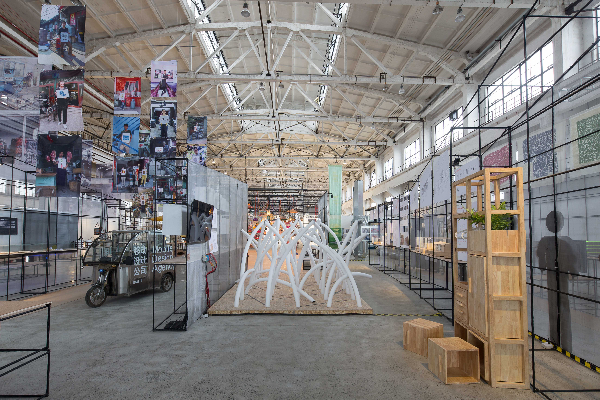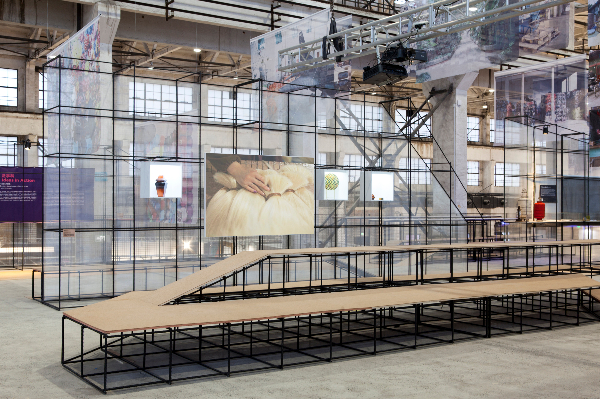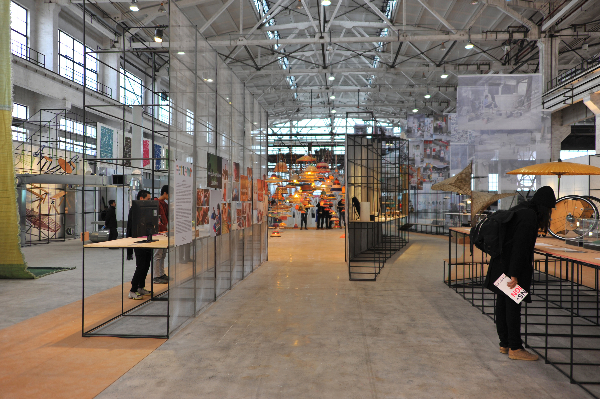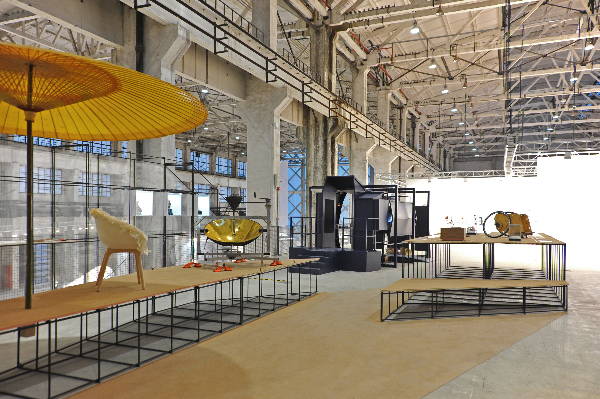”IDEAS in ACTION” in SHANGHAI ART&DESIGN 2016 ¬ TRANS-DESIGN
January 10 – March 15, 2016
West Bund Art Centre, Shanghai
Curator: Beatrice Leanza
IDEAS in ACTION is one of four core thematic exhibitions constitutive of the 2016 Shanghai Art&Design biennale, hosted in the 8000 sqm space of the West Bund Art Centre (a reclaimed hangar once used as an airplane repair shop).
Ideas in Action brings together multidisciplinary projects linking conceptual and practical strategies of design enactment that mobilize extant relations of production, inheritance and place into new conformations. The exhibition aims at offering a critical look at forms of integrated thinking found, inspired by or echoing across contemporary scenarios of change in China that span from object-to-city making by way of rerouting connections across the social, cultural and spatial givens of uneven or unattended frameworks of development. While their specificity of investigation is expansive in covering from urban and rural renewal to augmented methodologies of making, engaging craft-thinking and-digital knowledge or grassroots intelligence, a common denominator of positive value-making, co-actualization and a light-weight awareness of ethical like-mindedness, drives their action. The implicit premise to this assembly of positions is the recognition that design performs today as a ‘meta-project’ across disciplinary and systemic structures of both intangible and material nature, which must labour at the interplay of processes grounded in practical know-hows as much as empower culturally dispositional faculties of locational character. What draws shared significance to these projects is their dynamic positioning within generative networks of co-doing and combining of knowledge, their detouring within the remedial scale of actions that can rekindle broken or obsolete relations of production, inheritance and place into novel processes of mutuality and co-dependency. These practices advocate for design actions that are generated by a situationally shaped resourcefulness of humanistic and social engagement, while remaining committed to exploring the ideas and the technical boundaries that move the discipline towards new horizons.
The featured projects have been selected according to four analytical categories that portray distinct yet interwoven scales of operation. The categories are: Infrastructural Matrix, Growth Protocols, Infill, and Materiality & Objecthood. Although categorized according to these four subchapters, the selected projects are not so presented in site of the show, as the spatial narrative instead highlights their interconnections, as if extensions of a growing organism, laid along a ‘dynamic masterplan’ realized by Beijing-based reMIX Studio.
INFRUSTRUCTURAL MATRIX
The works here featured here unpack the workings of systems of development traversing various spatial and material registers – from urban and domestic, to places and forms of production (from studio to factory; from digital prototyping to artisanal remake), and the communities that inhabit them, thus eliciting how designers are finding new ways of constitutive interaction against shrinking economies, socially divided contexts and degrading or disappearing cultural heritages.
These include: urban spaces, domestic spaces, spaces of production (from studio to factory), social spaces and communities, systems of production (from digital prototyping to artisanal remake).
INFILL
As a dive into the first chapter, this section looks at specific projects that infiltrate orders of production (urban, industrial, social, architectural, etc.) by giving shape to novel solutions or simply poetic expressions emerging from within. These projects unveil what is unattended, invisible or underutilized by way of creative gestures turning those into new productive potential. Borrowed from architectural parlance, a strategic ‘infill’ is side-track thinking, it is a compounded approach that generates scalability out of extreme specificity.
These include: architectural projects, visual and graphic design, social design, industrial design.
GROWTH PROTOCOLS
This features programs that operate more specifically across the post-demographic scape of increasingly segmented user-and-consumer groups, devising new tools and systems to bring positive change to critical contexts, endangered or discarded constituencies.
These include: social design, digital and interaction design, product design.
MATERIALITY & OBJECTHOOD
The designers and creators selected for this section are more prominently working across material divides at the crossroads of new systems of ‘making’, rethinking traditional and artisanal forms and methodologies with the aid of contemporary technologies and skilling emerging as a result of changing systems of fabrication, distribution and ever more flexible and customizable possibilities of creation. Changing notion of aesthetic and material orders surface as a result.
Exhibition Design: reMIX Studio
Participants: 2×4 / Alexander Åhnebrink / Alvaro Catalan de Ozon / Anaide Gregory Studio / Atlas Studio / 白塔寺再生计划Baitasi Remade Project / 中央美术学院 -工业设计系Central Academy of Fine Arts – Industrial Design Department / 曹璞Cao Pu / 大木设计事务所DAMU Design / Studio Eva de Laat / From余杭融设计图书馆 & Pinwu 设计工作室From Yuhang – Rong Design Library & Pinwu /郝振瀚Hao Zhenhan / 黄明健Huang Mingjian / Instant Hutong-Studio Ramoprimo / LAVA Design Agency / 樂建筑 Le Architecture / LCD – Laboratory for Creative Design) / OPENDOT / 众建筑People’s Architecture Office / 临界工作室reMIX Studio / Studio S.W.I.N.E. & Andrew Friend / 清华大学 – 工业设计系Tsinghua University – Industrial Design Department / YEAH! Archkids
















